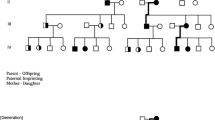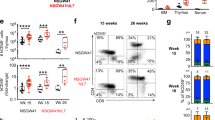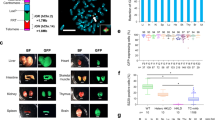Abstract
The maternally transmitted antigen (Mta) is expressed on the cells of most strains of mice1,2. It is a medial histocompatibility antigen3, that is, it is recognized by unrestricted cytotoxic T lymphocytes as are major H antigens, but unlike these it is a weak transplantation antigen and does not itself restrict the T-cell recognition of minor H antigens. All other medial H antigens are encoded by genes closely linked to the major histocompatibility complex3, H–2 in the mouse. By contrast, Mta appeared to follow extrachromosomal, maternal inheritance. Several substrains of NZB, NZO and non-inbred European NMRI mice are Mta-negative. Females of these strains bear only Mta− offspring, while females of the inbred Mta+ strains bear only Mta+ offspring. Repeated backcrossing from Mta+ females to NZB or NMRI males has shown that, given the right cytoplasmic genes, the chromosomal genes of these Mta− strains permit expression of Mta2. As the Mta type of a mouse cannot be influenced by embryo transfer or foster nursing2,4, we concluded that it was determined by a cytoplasmic factor (Mtf), transmitted through the egg. We now show that a gene, Hmt, closely linked to the H–2 complex, is also required for expression of Mta.
This is a preview of subscription content, access via your institution
Access options
Subscribe to this journal
Receive 51 print issues and online access
$199.00 per year
only $3.90 per issue
Buy this article
- Purchase on Springer Link
- Instant access to full article PDF
Prices may be subject to local taxes which are calculated during checkout
Similar content being viewed by others
References
Fischer Lindahl, K., Bocchieri, M. & Riblet, R. J. exp. Med. 152, 1583–1595 (1980).
Fischer Lindahl, K. & Hausmann, B. Genetics 103, 483–494 (1983).
Fischer Lindahl, K. & Langhorne, J. Scand. J. Immun. 14, 643–654 (1981).
Fischer Lindahl, K. & Bürki, K. Proc. natn. Acad. Sci. U.S.A. 79, 5362–5366 (1982).
Ferris, S. D., Ritte, U., Fischer Lindahl, K., Prager, E. M. & Wilson, A. C. Nucleic Acids Res. 11, 2917–2926 (1983).
Chan, T. & Fischer Lindahl, K. Ann. Rep. Basel Inst. Immun. 11, 90 (1982).
Winoto, A., Steinmetz, M. & Hood, L. Proc. natn. Acad. Sci. U.S.A. 80, 3425–3429 (1983).
Klein, J. The Biology of the Mouse Histocompatibility-2 Complex (Springer, New York, 1975).
Chapman, V. M., Nichols, E. A. & Ruddle, F. H. Biochem. Genet. 11, 347–358 (1974).
Chapman, V. M., Kratzer, P. G. & Quarantillo, B. A. Genetics 103, 785–795 (1983).
Shiroishi, T., Sagai, T. & Moriwaki, K. Nature 300, 370–372 (1982).
Klein, D., Tewarson, S., Figueroa, F. & Klein, J. Immunogenetics 16, 319–328 (1982).
Marshall, J. T. Jr, Bull. Am. Mus. natl. Hist. 158, 175–220 (1977).
Tada, N., Kimura, S., Hatzfeld, A. & Hämmerling, U. Immunogenetics 11, 441–449 (1980).
Kimura, S., Tada, N., Liu, Y. & Hämmerling, U. Immunogenetics 14, 445–447 (1981).
Tomonari, K., Tada, N., Kimura, S., Hämmerling, U. & Weksler, M. E. Immunogenetics 15, 605–608 (1982).
Chorney, M., Shen, F.-W., Michaelson, J. & Boyse, E. A. Immunogenetics 16, 91–93 (1982).
Ozato, K., Mayer, N. & Sachs, D. H. J. Immun. 124, 533–540 (1980).
Ozato, K., Mayer, N. & Sachs, D. H. Transplantation 34, 113–120 (1982).
Köhler, G., Fischer Lindahl, K. & Heusser, C. in The Immune System Vol. 2 (eds Steinberg, C. M. & Lefkovits, I.) 202–208 (Karger, Basel, 1981).
Lemke, H., Hämmerling, G. J. & Hämmerling, U. Immun. Rev. 47, 175–206 (1976).
Fischer Lindahl, K. & Lemke, H. Eur. J. Immun. 9, 526–536 (1979).
Author information
Authors and Affiliations
Rights and permissions
About this article
Cite this article
Lindahl, K., Hausmann, B. & Chapman, V. A new H–2-linked class I gene whose expression depends on a maternally inherited factor. Nature 306, 383–385 (1983). https://doi.org/10.1038/306383a0
Received:
Accepted:
Issue Date:
DOI: https://doi.org/10.1038/306383a0
This article is cited by
-
Hotspots of meiotic recombination in the mouse major histocompatibility complex
Genetica (1993)
-
Maps of mouse chromosome 17: First report
Mammalian Genome (1991)
-
Recombinational hotspot specific to female meiosis in the mouse major histocompatibility complex
Immunogenetics (1990)
-
An unexpectedly labile mitochondrially encoded protein is required for Mta expression
Immunogenetics (1989)
-
Analysis of a new class I gene mapping to theHmt region of the mouse
Immunogenetics (1989)
Comments
By submitting a comment you agree to abide by our Terms and Community Guidelines. If you find something abusive or that does not comply with our terms or guidelines please flag it as inappropriate.



